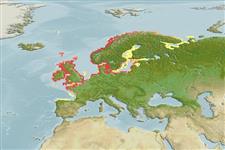Common names from other countries
Environment: milieu / climate zone / depth range / distribution range
Écologie
marin; saumâtre benthopélagique; non migrateur; profondeur 1 - 6 m (Ref. 130221). Temperate; 71°N - 43°N, 11°W - 55°E
Northeast Atlantic: north-western Europe.
Taille / Poids / Âge
Maturity: Lm ? range ? - ? cm
Max length : 22.0 cm SL mâle / non sexé; (Ref. 4119)
Épines dorsales (Total): 14 - 17. Front of body brassy-yellow in the male, with larger pectoral fins than in the female (Ref. 35388).
Adults live solitary or in pairs in weedy, shallow coastal areas (Ref. 4119). Feed on small invertebrates (Ref. 4119). Males build a nest from algae and debris, using kidney excrete as glue. Spawning season is May to June. Females deposit 150 - 200 eggs in the nest and often die shortly afterwards (Ref. 9900). Males care for and defend the nest. Offsprings reach maturity in one year (Ref. 4645).
Males build, guard and aerate the nest where the eggs are deposited (Ref. 205). Also Ref. 53335.
Muus, B.J. and P. Dahlström, 1974. Collins guide to the sea fishes of Britain and North-Western Europe. Collins, London, UK. 244 p. (Ref. 173)
Statut dans la liste rouge de l'IUCN (Ref. 130435)
CITES (Ref. 128078)
Not Evaluated
Menace pour l'homme
Harmless
Utilisations par l'homme
Pêcheries: sans intérêt
Plus d'informations
RéférencesAquacultureProfil d'aquacultureSouchesGénétiqueElectrophoresesHéritabilitéPathologiesTraitementMass conversion
Outils
Articles particuliers
Télécharger en XML
Sources Internet
Estimates based on models
Preferred temperature (Ref.
115969): 7.5 - 12.5, mean 9.9 (based on 512 cells).
Phylogenetic diversity index (Ref.
82804): PD
50 = 1.0000 [Uniqueness, from 0.5 = low to 2.0 = high].
Bayesian length-weight: a=0.00468 (0.00205 - 0.01068), b=3.04 (2.83 - 3.25), in cm Total Length, based on LWR estimates for this (Sub)family-body shape (Ref.
93245).
Niveau trophique (Ref.
69278): 3.5 ±0.37 se; based on food items.
Résilience (Ref.
120179): Haut, temps minimum de doublement de population inférieur à 15 mois (K=1.78; tm=1).
Fishing Vulnerability (Ref.
59153): Low vulnerability (17 of 100).
